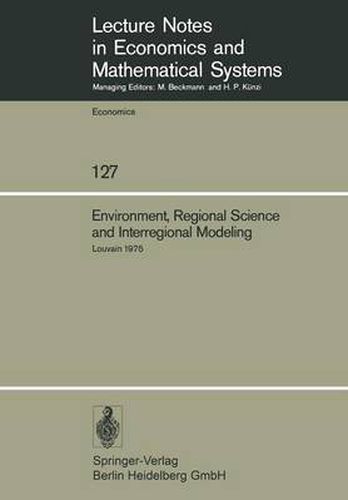Readings Newsletter
Become a Readings Member to make your shopping experience even easier.
Sign in or sign up for free!
You’re not far away from qualifying for FREE standard shipping within Australia
You’ve qualified for FREE standard shipping within Australia
The cart is loading…






This title is printed to order. This book may have been self-published. If so, we cannot guarantee the quality of the content. In the main most books will have gone through the editing process however some may not. We therefore suggest that you be aware of this before ordering this book. If in doubt check either the author or publisher’s details as we are unable to accept any returns unless they are faulty. Please contact us if you have any questions.
This second volume of proceedings of the International Conference on Regional Science, Energy and Environment (Louvain, May 1975) contains papers related to general and partial equilibrium models of regional and urban development, in which natural and human resources playa dominant role. It need not be stressed that environmental factors and resource management have,to some extent, been neglected in postwar economic research. Unfortunately, a world-wide energy crisis or more local environmental disruptions were necessary to draw the economist’s attention on the increasing imbalance between man and environment. The topics treated in this volume reflect the shift in economic research which has taken place since the early seventies. They can be classified roughly into 4 fields. The first field deals with a welfare approach to environmental deterioration. The second area covers models of resource allocation that contain environmental constraints. The third class of problems focuses on the relationship between environment and urban development. Finally, some methodological papers are included that explore new areas in regional and ~nterregional model building. Klaassen opens this volume with a paper on the impact of rising energy prices on the structure of regional development and environment, He analyses the change in size of all potentials and the consequent decrease in the volume of traffic. Besides these short-run influences, a :reallocat{o~ of households and firms may be expected in the long-run.
$9.00 standard shipping within Australia
FREE standard shipping within Australia for orders over $100.00
Express & International shipping calculated at checkout
This title is printed to order. This book may have been self-published. If so, we cannot guarantee the quality of the content. In the main most books will have gone through the editing process however some may not. We therefore suggest that you be aware of this before ordering this book. If in doubt check either the author or publisher’s details as we are unable to accept any returns unless they are faulty. Please contact us if you have any questions.
This second volume of proceedings of the International Conference on Regional Science, Energy and Environment (Louvain, May 1975) contains papers related to general and partial equilibrium models of regional and urban development, in which natural and human resources playa dominant role. It need not be stressed that environmental factors and resource management have,to some extent, been neglected in postwar economic research. Unfortunately, a world-wide energy crisis or more local environmental disruptions were necessary to draw the economist’s attention on the increasing imbalance between man and environment. The topics treated in this volume reflect the shift in economic research which has taken place since the early seventies. They can be classified roughly into 4 fields. The first field deals with a welfare approach to environmental deterioration. The second area covers models of resource allocation that contain environmental constraints. The third class of problems focuses on the relationship between environment and urban development. Finally, some methodological papers are included that explore new areas in regional and ~nterregional model building. Klaassen opens this volume with a paper on the impact of rising energy prices on the structure of regional development and environment, He analyses the change in size of all potentials and the consequent decrease in the volume of traffic. Besides these short-run influences, a :reallocat{o~ of households and firms may be expected in the long-run.